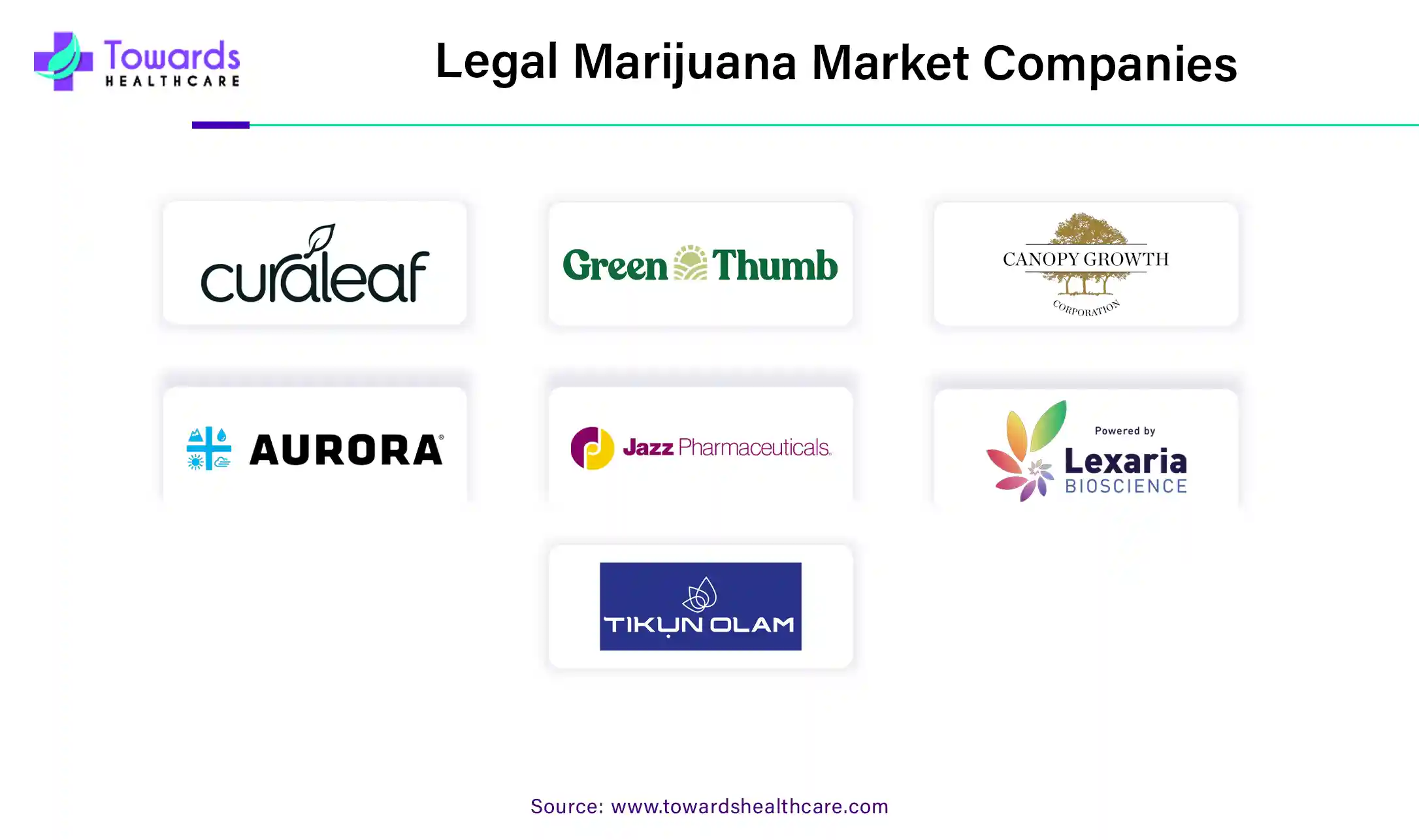April 2025

.webp)
Principal Consultant

Reviewed By
The legal marijuana market is anticipated to grow from USD 40.24 billion in 2025 to USD 135.06 billion by 2034, with a compound annual growth rate (CAGR) of 14.4% during the forecast period from 2025 to 2034.

In 2021, the National Institute of Health estimates that 36 states allow medical marijuana, but the rules for getting it vary. Even though it's legal in many places, medical marijuana is highly recommended for chronic pain management.
Marijuana is a plant that is commonly used for recreational and medicinal purposes. It contains a chemical called THC, which is responsible for the "high" feeling. People may smoke, vape, or eat marijuana for various effects, including relaxation and pain relief. However, it's important to note that its legal status varies across different places. Legal marijuana refers to the regulated cultivation, sale, and use of cannabis within the boundaries of specific laws. It's a significant shift in how society views and manages the use of marijuana. The legalization can be categorized into two main types: recreational and medicinal.
In places where recreational marijuana is legal, adults can use it for non-medicinal purposes. This often involves regulations on age restrictions, permissible quantities, and locations for consumption. Legalizing marijuana for medicinal purposes means that doctors can prescribe it to treat certain medical conditions. This recognizes marijuana's potential therapeutic benefits.
There is a growing movement in the United States advocating for the legalization of marijuana for both medicinal and recreational purposes. Many states have already enacted laws to this effect. The push for legalization is largely driven by the potential economic benefits, including increased tax revenues, job creation, and investment opportunities. Currently, 24 states, three territories, and the District of Columbia have legalized recreational marijuana use, while 38 states, three territories, and the District of Columbia permit medical marijuana use.
One of the most immediate benefits of marijuana legalization is the boost in tax revenue. In 2023, states collectively generated over $4.18 billion in tax revenue from marijuana sales. California led the way, collecting $1.1 billion in sales tax from cannabis. Washington and Colorado, the pioneers of recreational marijuana legalization, have seen substantial tax revenues since 2014. Washington amassed $4.1 billion, while Colorado collected $2.38 billion in marijuana tax revenue during this period.
Legalizing marijuana nationwide could further increase tax revenues across other states and at the federal level, enhancing the economic impact of legalization.
Several U.S. States have Legalized Marijuana for Recreational and Medicinal Use
| Recreational Use | Medicinal Use |
| Colorado | Arizona |
| Washington | Arkansas |
| Alaska | Connecticut |
| California | Florida |
| Nevada | Hawaii |
| Michigan | Maryland |
| Massachusetts | Minnesota |
| Illinois | Missouri |
| Maine | New Mexico |
| Montana | North Dakota |
| New Jersey | Pennsylvania |
| New York | Rhode Island |
| Other 12 States | Utah |
| West Virginia | |
| Other 20 States |
The medicinal use of marijuana has indeed contributed to the growth of the global legal marijuana market. The increasing acceptance of cannabis for medical purposes has led to the legalization of medical marijuana in numerous countries and states. This has created a burgeoning market for legal cannabis products, such as oils, tinctures, and capsules, customized to address various medical conditions.

One key factor driving this demand is the therapeutic potential of cannabinoids, the active compounds in marijuana. Cannabidiol (CBD), for instance, is renowned for its purported anti-inflammatory and analgesic properties, making it a popular choice for conditions like chronic pain and certain neurological disorders. As more research is conducted on the medical benefits of marijuana, there's a growing understanding of its potential applications in treating conditions like epilepsy and anxiety and even in alleviating the side effects of chemotherapy.
The changing societal attitudes toward marijuana have paved the way for increased legalization, not only for medical but also for recreational use in some regions. This has created a more robust legal framework, fostering a legitimate and regulated market. As governments recognize the economic potential of the cannabis industry, they are more inclined to implement policies that support its growth. The medicinal use of marijuana has undeniably played a significant role in boosting the global demand for legal marijuana.

Legalization aims to balance individual freedom, public health and economic considerations. As with any substance, moderation and understanding the legal framework are critical to a positive and responsible experience.
The growing acceptance of marijuana for both medical and recreational purposes can be attributed to shifting societal attitudes and an expanding understanding of its potential benefits. Regarding medical use, numerous studies suggest that cannabinoids, the compounds found in marijuana, possess therapeutic properties. These properties range from alleviating chronic pain and reducing chemotherapy-induced nausea to enhancing appetite in conditions such as HIV/AIDS. As awareness of these potential medical benefits increases, there is a noticeable trend towards recognizing marijuana as a valid and effective medical treatment.
On the recreational front, changing attitudes challenge traditional stigmas linked to marijuana use. Many now perceive it as a means to relax and unwind, comparable to consuming a glass of wine. As societies become more open-minded, the concept of responsible recreational marijuana use gains traction, further contributing to its acceptance. The economic impact of legalizing marijuana is a substantial driver in its growing acceptance. The legalization process creates new industries, generates tax revenue, and offers job opportunities. Governments, recognizing these financial advantages, are more inclined to support and promote the acceptance of marijuana.
Additionally, equally significant is the evolving public opinion surrounding marijuana. As individuals share positive experiences, whether related to medical or recreational use, stereotypes associated with marijuana are breaking down. This shift in perception plays a crucial role in fostering acceptance and broadening the understanding of marijuana's role in society.
The rising global demand for legal marijuana in pain management is fueled by a combination of factors that collectively drive the expansion of this market. First and foremost, the efficacy of marijuana, particularly cannabinoids like THC and CBD, in alleviating various types of pain, including chronic conditions, has positioned it as a compelling alternative to traditional pain medications. This effectiveness has led to a growing interest and demand among individuals seeking alternative pain relief solutions. A crucial contributor to the increasing demand is the shifting regulatory landscape globally. As more countries and regions legalize the medical use of marijuana, there is a broader acceptance of its role in pain management. This regulatory shift not only legitimizes the cultivation, distribution, and use of marijuana but also creates new opportunities for the growth of the legal marijuana market on a global scale.

For Instance,
Public awareness and education about the potential therapeutic benefits of marijuana for pain management are pivotal in driving its increased demand. Both patients and healthcare professionals are becoming more informed about the therapeutic properties of cannabinoids, fostering greater acceptance and growing demand for legal marijuana products designed for pain relief. Changing societal attitudes towards cannabis also plays a significant role in the surge of demand. With an increasing number of people viewing marijuana as a legitimate and effective option for pain relief, individuals are becoming more open to incorporating it into their pain management strategies, contributing to the overall uptick in demand. Additionally, the legal marijuana industry presents substantial economic opportunities. Governments, recognizing the potential for tax revenue and job creation, are incentivized to support and facilitate the legal cultivation and distribution of marijuana for medical purposes. This economic aspect further propels the global expansion of legal marijuana markets in the context of pain management.
Ongoing research into the medicinal properties of cannabinoids is a driving force behind the innovation of marijuana-based products tailored specifically for pain management. This continuous evolution in product offerings adds to the sustained demand for legal marijuana in the global market. The increased international demand for legal marijuana in pain management is a multifaceted phenomenon driven by its perceived efficacy, changing regulations, heightened awareness, evolving societal attitudes, economic incentives, and ongoing research advancements. These interconnected factors collectively contribute to the growing acceptance and utilization of legal marijuana as a viable option in pain management on a global scale.
Regulatory hurdles act like speed bumps for the legal marijuana market. Imagine you're driving on a road, and suddenly, there are many rules and restrictions. In the marijuana market, these rules come from the government. Different states have different rules about growing, selling, and using marijuana. It's like having different traffic rules in each city you visit.
Additionally, even in states where it's legal, there are often many specific regulations to follow. For example, businesses might need licenses, and there could be limits on how much marijuana they can grow or sell. Furthermore, here's the tricky part: because marijuana is still illegal under federal law in some places, businesses face challenges with things like banking. Imagine not being able to use regular banks for your business transactions – that makes it challenging to manage money and grow the business smoothly. So, these regulatory hurdles are like a bunch of roadblocks that slow down the progress of the legal marijuana market, making it harder for companies to thrive.
The geographical landscape for legal marijuana in North America is evolving, with various states and countries adopting different approaches. States like California, Oregon, and Washington were among the pioneers in legalizing recreational marijuana. They have established mature markets with a wide range of products and services. Mexico has taken steps toward legalizing recreational marijuana, which could significantly impact the overall North American market.
For Instance,
Germany has a legalized medical marijuana program, and it has become one of the largest medical cannabis markets in Europe. Patients with certain conditions can access medical cannabis through pharmacies. Switzerland allows low-THC cannabis products with less than 1% THC content, creating a unique market for products like CBD.
The Asia Pacific region generally has strict regulations on marijuana, with limited instances of legalization for medical purposes in some areas. Australia has legalized the use of medical cannabis at the federal level. However, regulations vary by state, and access can be challenging.
For Instance,
Some states have also decriminalized small amounts of recreational use. In New Zealand, a 2020 referendum on recreational cannabis legalization did not pass. However, there is an existing medical cannabis program allowing for the use of medicinal marijuana under certain conditions.
The legal marijuana market has a dynamic competitive landscape with various players operating across cultivation, distribution, and retail. Key factors include regulatory environments, product diversity, and brand positioning. Regional regulations significantly impact market dynamics, shaping the competitive strategies of industry participants. Ongoing developments, mergers, and partnerships contribute to the fluidity of the legal marijuana market's competitive landscape. As the medical cannabis industry continues its global expansion, the competitive dynamics within the market are anticipated to experience additional transformation.
The rapidly changing scenario of the legal marijuana industry:

By Product Type
By Application
By Geography
April 2025
March 2025
March 2025
March 2025